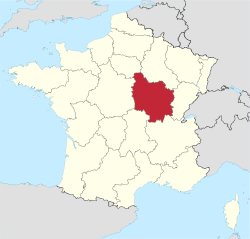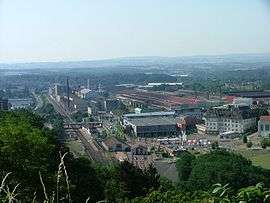Burgundy
| Burgundy Bourgogne | ||
|---|---|---|
| Region of France | ||
| ||
 | ||
| Country |
| |
| Prefecture | Dijon | |
| Departments | ||
| Government | ||
| • President | François Patriat (PS) | |
| Area | ||
| • Total | 31,582 km2 (12,194 sq mi) | |
| Population (2008-01-01) | ||
| • Total | 1,631,000 | |
| • Density | 52/km2 (130/sq mi) | |
| Time zone | CET (UTC+1) | |
| • Summer (DST) | CEST (UTC+2) | |
| ISO 3166 code | FR-D | |
| GDP (2012)[1] | Ranked 16th | |
| Total | €42.7 billion (US$55.0 bn) | |
| Per capita | €25,996 (US$33,436) | |
| NUTS Region | FR2 | |
| Website | cr-bourgogne.fr | |
Burgundy (French: Bourgogne, IPA: [buʁ.ɡɔɲ]) is a historical territory and a former administrative region of east-central France. Since 1 January 2016, it is part of the new region Bourgogne-Franche-Comté.[2] Burgundy comprises the following four departments: Côte-d'Or, Saône-et-Loire, Yonne and Nièvre.
Burgundy takes its name from the Burgundians, a Germanic people.
Historically, "Burgundy" has referred to numerous political entities, including kingdoms and duchies spanning territory from the Mediterranean to the Low Countries.
History

The first known inhabitants of the area that became Burgundy were Celts, who were incorporated in the Roman Empire as Gallo-Romans.
During the 4th century, the Burgundians, a Germanic people, who may have originated in Bornholm (on the Baltic Sea), settled in the western Alps. They founded the Kingdom of the Burgundians, which was conquered in the 6th century by another Germanic tribe, the Franks.

Under Frankish dominion, the Kingdom of Burgundy continued for several centuries.
Later, the region was divided between the Duchy of Burgundy (to the west) and the Free County of Burgundy (to the east). The Duchy of Burgundy is the better-known of the two, later becoming the French province of Burgundy, while the County of Burgundy became the French province of Franche-Comté, literally meaning free county.
Burgundy's modern existence is rooted in the dissolution of the Frankish Empire. In the 880s, there were four Burgundies, which were the Kingdom of Upper and Lower Burgundy, the duchy and the county.
During the Middle Ages, Burgundy was the seat of some of the most important Western churches and monasteries, among them Cluny, Cîteaux, and Vézelay.
During the Hundred Years' War, King John II of France gave the duchy to his youngest son, Philip the Bold. The duchy soon became a major rival to the crown. The court in Dijon outshone the French court both economically and culturally. In 1477, at the battle of Nancy during the Burgundian Wars, the last duke Charles the Bold was killed in battle, and the Duchy itself was annexed by France and became a province. However the northern part of the empire was taken by the Austrian Habsburgs.
With the French Revolution in the end of the 18th century, the administrative units of the provinces disappeared, but were reconstituted as regions during the Fifth Republic in the 1970s. The modern-day administrative region comprises most of the former duchy.
Geography
.svg.png)
The region of Burgundy is both larger than the old Duchy of Burgundy and smaller than the area ruled by the Dukes of Burgundy, from the modern Netherlands to the border of Auvergne. Today, Burgundy is made up of the following old provinces:
- Burgundy: Côte-d'Or, Saône-et-Loire, and southern half of Yonne. This corresponds to the old duchy of Burgundy (later called province of Burgundy). However, the old county of Burgundy (later called province of Franche-Comté) is not included inside the Burgundy region, but it makes up the Franche-Comté region. Also, a small part of the duchy of Burgundy (province of Burgundy) is now inside the Champagne-Ardenne region.
- Nivernais: now the department of Nièvre.
- the northern half of Yonne is a territory that was not part of Burgundy (at least not since the 11th century), and was a frontier between Champagne, Île-de-France, and Orléanais, being part of each of these provinces at different times in history.
Major communities


Climate
The climate of this region is essentially oceanic (Cfb in Köppen classification), with a continental influence (sometimes called a "half-continental climate").
Politics
The regional council of Burgundy is the legislative assembly. Its seat is in the capital city Dijon, at 17 boulevard de la Trémouille.
Since 2004 the council is chaired by the Socialist François Patriat.
Culture
Wine

Burgundy is one of France's main wine producing areas. It is well known for both its red and white wines, mostly made from Pinot noir and Chardonnay grapes, respectively, although other grape varieties can be found, including Gamay, Aligote, Pinot blanc, and Sauvignon blanc. The region is divided into the Côte-d'Or, where the most expensive and prized Burgundies are found, and Beaujolais, Chablis, the Côte Chalonnaise and Mâcon.
The reputation and quality of the top wines, together with the fact that they are often produced in small quantities, has led to high demand and high prices, with some Burgundies ranking among the most expensive wines in the world.
Cuisine
Famous Burgundian dishes include coq au vin, beef bourguignon, and époisses de Bourgogne cheese.
Sites
Some tourist sites include the Rock of Solutré, the Tournus cathedral, Cluny, Brancion, the castles of Cormatin and Couches, the palace of the dukes of Burgundy in Dijon, the Pézanin Arboretum (in Dompierre-les-Ormes), and Vézelay Abbey.
Industry
Earlier, the southeastern part of Burgundy was heavily industrial, with coal mines near Montceau-les-Mines and iron foundries and crystal works in Le Creusot. These industries declined in the second half of the twentieth century, and Le Creusot has tried to reinvent itself as a tourist town.
References
Further reading
- Lecomte, Bernard; Thouart, Jean-Louis (2004). Burgundy, What a Story! (de Bourogne ed.). ISBN 978-2-902650-02-6.
- Davies, Norman (2011). "Ch.3 : Burgundia: Five, Six or Seven Kingdoms (c. 411-1795)". Vanished Kingdoms: The History of Half-Forgotten Europe. London: Allan Lane. ISBN 978-0-141-04886-4.
External links
| Wikivoyage has a travel guide for Burgundy. |
| Wikisource has the text of the 1911 Encyclopædia Britannica article Burgundy. |
| Look up burgundy in Wiktionary, the free dictionary. |
| Wikimedia Commons has media related to Burgundy. |
- (English) Burgundy : history in the open air—Official French website
- (French)Burgundy statistics on INSEE website
- (French) Regional Council website
- (English) Short guide to Burgundy with main tourist attractions
- (English) Burgundy at DMOZ
- Burgundy in the 1913 Catholic Encyclopedia at BibleWiki
- Burgundy in the 1913 Catholic Encyclopedia at NewAdvent.org
Coordinates: 47°00′N 4°30′E / 47.000°N 4.500°E


